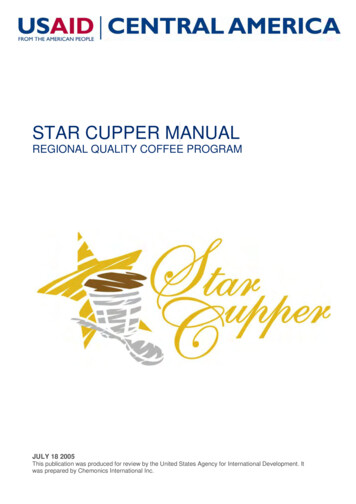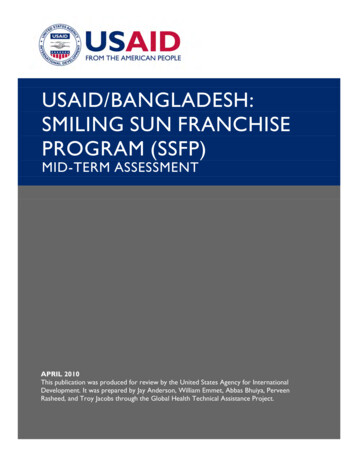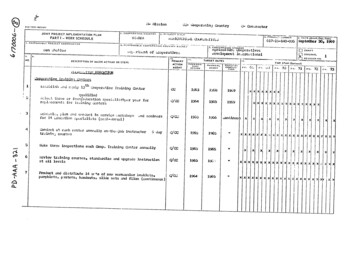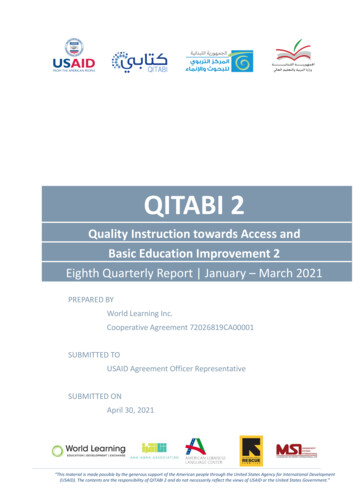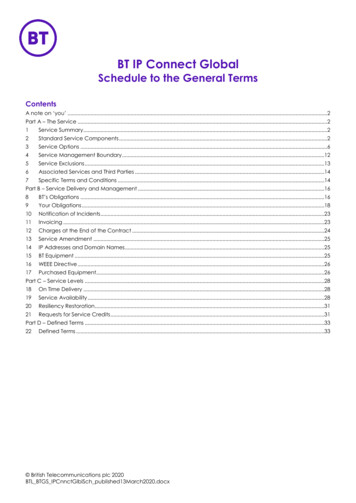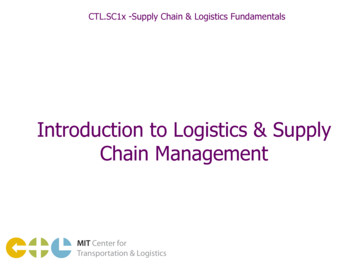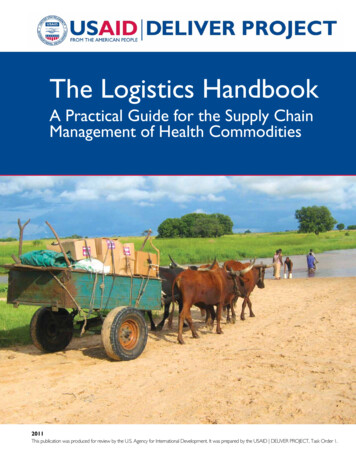
Transcription
The Logistics HandbookA Practical Guide for the Supply ChainManagement of Health Commodities2011This publication was produced for review by the U.S. Agency for International Development. It was prepared by the USAID DELIVER PROJECT, Task Order 1.
The Logistics HandbookA Practical Guide for the Supply Chain Management ofHealth CommoditiesThe authors’ views expressed in this publication do not necessarily refect the views of the United States Agency forInternational Development or the United States Government.
USAID DELIVER PROJECTTe USAID DELIVER PROJECT, Task Order 1, is funded by the U.S. Agency for International Development under contractno. GPO-I-01-06-00007-00, beginning September 29, 2006. Task Order 1 is implemented by John Snow, Inc., in collaboration withPATH; Crown Agents Consultancy, Inc.; Abt Associates; Fuel Logistics Group (Pty) Ltd.; UPS Supply Chain Solutions; Te ManofGroup; and 3i Infotech. Te project improves essential health commodity supply chains by strengthening logistics management informationsystems, streamlining distribution systems, identifying fnancial resources for procurement and supply chain operation, and enhancingforecasting and procurement planning. Te project encourages policymakers and donors to support logistics as a critical factor inthe overall success of their health care mandates.Recommended CitationUSAID DELIVER PROJECT, Task Order 1. 2011. Te Logistics Handbook: A Practical Guide for the Supply Chain Management of HealthCommodities. Arlington, Va.: USAID DELIVER PROJECT, Task Order 1.Second edition (First edition 1998)AbstractTe Logistics Handbook: A Practical Guide for the Supply Chain Management of Health Commodities ofers practical guidance in managing thesupply chain, with an emphasis on health commodities. Tis handbook will be particularly useful for program managers who design,manage, and assess logistics systems for health programs. In addition, policymakers, system stakeholders, and anyone working in logisticswill also fnd it helpful as a system overview and overall approach.Key terms and concepts are clearly defned and explained; the document includes detailed information about the design andimplementation of logistics management information systems and inventory control systems. Overviews of quantifcation,procurement processes, as well as storage, transport, and product selection, are also included.AcknowledgmentsTe USAID DELIVER PROJECT would like to express its appreciation to the many people who worked on and contributed toTe Logistics Handbook: A Practical Guide for the Supply Chain Management of Health Commodities. Te original handbook was based on thefagship logistics course taught by the USAID DELIVER PROJECT staf (then the Family Planning Logistics Management projectstaf). In 1992, Barbara Felling and Walter Proper developed the course, and ofered it to logisticians outside the project for the frst time.Te project’s Performance Improvement team continued to develop the course, providing many iterations and additional material. In 1998, toincrease the number of participants for the course, Barry Chovitz, a trainer and course developer since 1992, developed the handbookand led the efort to turn the extensive training curriculum into a textbook. Barbara Felling updated the handbook in 2004 to refectnew project knowledge. In 2010, a team of USAID DELIVER PROJECT technical advisors and staf solicited input from all technical teamsto make the most signifcant revision and update to the complete handbook since it was frst published in 1998. Major contributersincluded Claudia Allers, Dana Aronovich, Jaya Chimnani, Todd Dickens, Paul Dowling, Barbara Felling, Carolyn Hart, Alexis Heaton,Rich Owens, Leslie Patykewich, Gregory Roche, Eric Takang, and Edward Wilson. Te lead review team included Lilia Gerberg, KellyHamblin, Erin Hasselberg, Naomi Printz, and Ashley Smith. Gus Osorio designed the graphics and the layout. Pat Shawkey was theeditor. Te stand-alone handbook is based on a wide range of knowledge and information from staf throughout the project.Cover photo: During the rainy season an ox cart is the only reliable way to get health commodities across the fooded plains to ruralhealth centers in Zambia’s western province. (USAID DELIVER PROJECT 2010).USAID DELIVER PROJECTJohn Snow, Inc.1616 Fort Myer Drive, 11th FloorArlington, VA 22209 USAPhone: 703-528-7474Fax: 703-528-7480Email: askdeliver@jsi.comInternet: deliver.jsi.com
ContentsAcronyms . viiPreface . ix1 .Introduction.to.Logistics . 1Objectives.11.1 What Is Logistics? .11.2 Why Logistics Matters .21.3 Logistics System .31.4 Logistics Cycle: Organizing Logistics System Activities .51.5 Key Logistics Terms .91.6 More Logistics Terms . 11Chapter Summary. 162. .Logistics.Management.Information.Systems. 17Objectives. 172.1 Logistics Management Information Systems . 182.2 Essential Data for Decisionmaking. 182.3 Three Types of Logistics Records . 192.4 Reporting Systems and Summary Reports . 332.5 Using an LMIS for Decisionmaking . 41Chapter Summary. 423. .Assessing.Stock.Status. 43Objectives. 433.1 Assessing Stock Status . 433.2 How to Assess Stock Status. 443.3 When to Assess Stock Status . 463.4 Stock Status Assessment at Any Level in the System . 46Chapter Summary. 534. .Maximum-Minimum.Inventory.Control.Systems. 55Objectives. 554.1 Purpose of an Inventory Control System . 554.2 Key Inventory Control Terms . 564.3 Three Types of Max-Min Inventory Control Systems . 574.4 Determining How Much to Order or Issue . 574.5 Determining When to Place an Order or Issue . 584.6 Setting Max-Min Levels . 644.7 Two Design Issues for Inventory Control Systems . 694.8 Selecting an Appropriate Max-Min System . 71Chapter Summary . 755. .Product.Selection. 77Objectives. 775.1 Purpose of Product Selection . 775.2 National Essential Medicines List . 785.3 Registration of Pharmaceutical Products . 795.4 Standard Treatment Guidelines. 805.5 Donor Requirements . 815.6 Laboratory Supplies and Equipment Standardization . 81Chapter Summary. 83
ivTHE LOGISTICS HANDbOOK A PRACTICAL GUIDE fOR THE SUPPLy CHAIN MANAGEMENT Of HEALTH COMMODITIES6. .Quantifcation.of.Health.Commodities. 85Objectives. 856.1 Importance of Quantifcation . 866.2 Key Steps in Quantifcation . 866.3 Using the Quantifcation Results . 956.4 Reviewing and Updating the Quantifcation . 96Chapter Summary. 987. .Health.Commodity.Procurement. 99Objectives. 997.1 Why Procurement in the Supply Chain Is Important . 997.2 Procurement Process . 1017.3 Key Challenges faced in Procurement . 108Chapter Summary. 1118. .Storage.and.Distribution.113Objectives. 1138.1 Storage . 1148.2 Visual Inspection. 1188.3 Storage Space Requirements . 1208.4 Physical Inventory Count . 1228.5 Health Care Waste Management. 1238.6 Distribution . 124Chapter Summary . 1269. ectives. 1299.1 Monitoring and Evaluation basics . 1299.2 Developing an M&E Plan . 1329.3 Indicators for M&E of Supply Chains . 1359.4 Data Collection Methodologies . 1379.5 Data Collection Tools . 1399.6 Providing feedback and Reporting Results . 141Chapter Summary . 14210. .Logistics.System.Design.143Objectives. 14310.1 Logistics System Design Process. 14310.2 System Design Elements . 14810.3 Other Design Considerations . 152Chapter Summary. 156Resources.157References.159Figuresfigure 1-1: Correlation between Contraceptive Prevalence Rate and Product Availability .3figure 1-2: The Logistics Cycle .5figure 1-3: Typical Public Sector In-Country Supply Pipeline . 10figure 2-1: The Logistics Cycle . 17figure 2-2: bin Card . 21figure 2-3: Inventory Control Card . 22figure 2-4: Stores Ledger (cover, table of contents, product page). 23figure 2-5: Issue and Receipt Voucher . 25figure 2-6: Issue and Receipt Voucher flow . 26
vfigure 2-7: Requisition, Issue, and Receipt Voucher . 27figure 2-8: Requisition, Issue and Receipt Voucher flow . 28figure 2-9: Daily Activity Register . 30figure 2-10: Daily Usage Log . 31figure 2-11: Tick Sheet. 32figure 2-12: Sample Logistics Reporting System: National Vaccine Program . 34figure 2-13: Monthly Report and Request for ARVs (last page of a four-page form) . 37figure 2-14: feedback Report. 40figure 2-15: Decisionmaking Process . 41figure 3-1: Stock Status Assessment . 49figure 4-1: fuel Gauge . 56figure 4-2: Lead Times . 64figure 5-1: The Logistics Cycle . 77figure 6-1: The Logistics Cycle . 85figure 6-2: Steps in Quantifcation . 86figure 7-1: The Logistics Cycle . 99figure 8-1: The Logistics Cycle . 113figure 8-2: Sharps box. 123figure 9-1: Program Cycle for Supply Chain Systems Improvement. 130figure 9-2: Relationship between Goals, Objectives, Interventions, and Indicators . 135figure 10-1: Logistics System Design Process. 143TablesTable 1-1: Advantages and Disadvantages of Allocation and Requisition Systems. 12Table 2-1: Three Essential Logistics Data Items . 19Table 4-1: Sample Max-Min Levels. 69Table 4-2: factors for Selecting a Max-Min Inventory Control System. 73Table 6-1: Preparation Process . 87Table 6-2: forecasting Process . 88Table 6-3: Types and Sources of Data for forecasting Product Consumption . 89Table 6-4: Data Quality Analysis for ARV Drug Quantifcation in Tanzania . 90Table 6-5: Conversion of Data into Product Quantities . 91Table 6-6: Supply Planning Process. 93Table 6-7: Supply Planning Data Requirements . 93Table 7-1: The Product Supply Process (PATH 2009) . 102Table 8-1: Storage Guidelines . 116Table 8-2: Common Product Quality Problems . 119Table 8-3. How to Calculate floor Space . 121Table 9-1: Objectives and Interventions Worksheet . 133Table 9-2: M&E Workplan Worksheet . 134Table 10-1: Summary of Implications of System Design Decisions. 155
viTHE LOGISTICS HANDbOOK A PRACTICAL GUIDE fOR THE SUPPLy CHAIN MANAGEMENT Of HEALTH COMMODITIES
IVabstinence, be faithful, use condomsacquired immune defciency syndromeartemether lumefantrine (antimalarial medicine)average monthly consumptionacute respiratory infectionantiretroviral therapyantiretroviralAssessment Tool for Laboratory Servicecommunity-based distributor or distributionCentral Medical Storescontraceptive prevalence rateCouncil of Supply Chain Management Professionalscouple-years of protectiondaily activity registerDemographic and Health Surveydelivery truck topping-up (inventory control system)essential medicines listemergency order pointExpanded Programme on ImmunizationU.S. Food and Drug Administrationfrst-to-expire, frst-outfrst-in, frst-outFamily Planning Logistics ManagementFamily Planning Technical Working GroupGlobal Fund to Fight AIDS, Tuberculosis and Malariageographic information systemgood manufacturing practiceGhana Social Marketing Foundationhealth care wastehealth care workerhealth information systemhuman immunodefciency virushealth management information systeminventory control cardinventory control systeminformation, education, and communicationinventory control systeminternational non-proprietary nameInternational Planned Parenthood Federationissue and receipt voucherInternational Organization for Standardizationintrauterine deviceissue voucher
viiiTHE LOGISTICS HANDbOOK A PRACTICAL GUIDE fOR THE SUPPLy CHAIN MANAGEMENT Of HEALTH VENVMIVPPWBDWHOWRAJohn Snow, Inc.key performance indicatorsLogistics Indicator Assessment Toollogistics management information systemLogistics Management UnitLogistics System Assessment Toolmonitoring and evaluationmean absolute percent errormanagement information systemMinistry of HealthMinistry of Health and Social Welfarenational drug regulatory authoritynongovernmental organizationOrganization for Eastern Caribbean Stateson-the-job trainingoral rehydration saltsPan American Health Or
Te Logistics Handbook: A Practical Guide for the Supply Chain Management of Health Commodities. ofers practical guidance in managing the supply chain, with an emphasis on health commodities. Tis handbook will be particularly useful for program managers who design,


